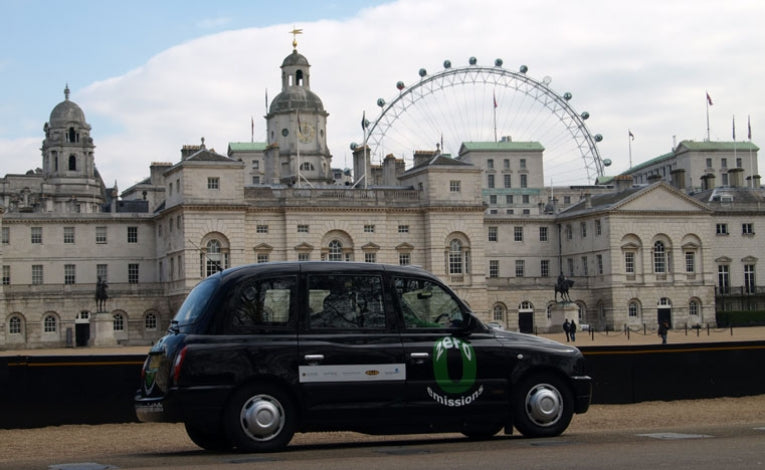Image: The Fuel Cell taxi in central London with the London Eye in the background.
A consortium of innovative companies have created a pair of prototype zero emission fuel cell London taxis - the famous 'Black Cabs' that carry passengers around London. Though looking exactly like the familiar taxis - they are conversions, underneath the hood they have an electric motor powered by a hydrogen fuel cell and batteries, and besides emitting no carbon while they zoom round London, have been praised for a superior, silent ride and improved performance over the diesel engine that powers the rest of London's 22,000 taxis.
The two prototypes which have been certified as road-legal have done about 8000 miles of testing on track and street. They are to be part of a fleet of 15 which will ferry Olympians, VIPs and guests around London during the 2012 Olympic Games. Essentially this is to road test the vehicles, and after the games the vehicles are expected to be available to paying passengers as part of the public transport network.
The zero emission taxis have been developed by a consortium led by Intelligent Energy, which includes Lotus Engineering, London Taxis International and TRW Conekt with part-funding from the UK Government’s Technology Strategy Board. The fuel cell and battery-powered hybrid taxi has a 250 mile driving range with rapid refuelling, with a top speed of 85 mph, all within the confines of the body of a conventional London taxi. Dennis Hayter, VP of Business Development for Intelligent Energy says, ''The electric power train is very quiet and because of its greater efficiency and the weight reduction, the taxi gives a smooth acceleration to 60 mph which is much swifter than its diesel counterparts. There is an all-round improved passenger experience, and no reduction in luggage capacity.'' Because it has fewer moving parts the taxi is expected to have lower maintenance and running costs than a conventional one, while retailing at approximately the same price, which will incentivise taxi companies to buy the new vehicle.

But the taxis will need hydrogen fuelling stations. Already there is one for hybrid buses, and the taxis will be able to use that. Two more are being implemented and it is hoped to have six available in time for the Olympics. Hayter says that it is projected London would need 28-34 if all of London's taxis converted to hydrogen fuel cell operation. The hydrogen is supplied in liquid form, but is gaseous in the storage tanks and thus is stable with little evaporation ''boil-off''. Refuelling takes 3 minutes, which is approximately the same duration as any other similar car.

The export potential of the fuel cell vehicle looks promising. Already Intelligent Energy have had interest from the municipalities of New York, San Francisco and Los Angeles. If the taxis are successful in London, then they are likely to be in demand all over the world. Hayter continues, ''We took a decision to use a 2 ½ ton taxi to test the concept. We have shown that the fuel cell power train can work in a vehicle of this weight, and so it has all sorts of other applications: small vans and other commercial vehicles, and hybrid minibuses. We can build on the knowledge we have gained and will be testing and modifying it during the next few years so we expect that our improved version of commercial hybrid taxis will be on the streets of London by 2016.''
Photos: courtesy Intelligent EnergyLink: Intelligent Energy.










